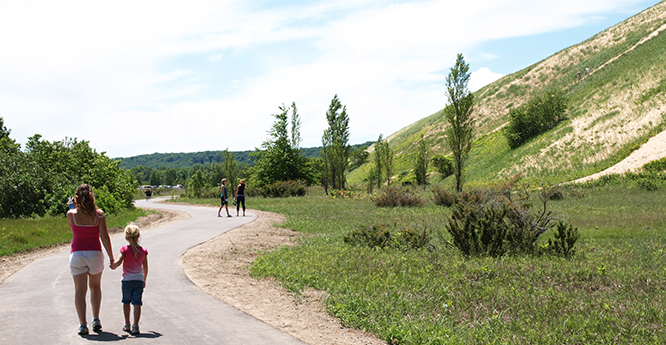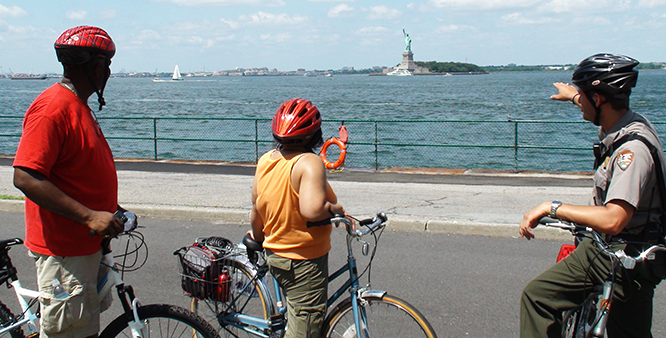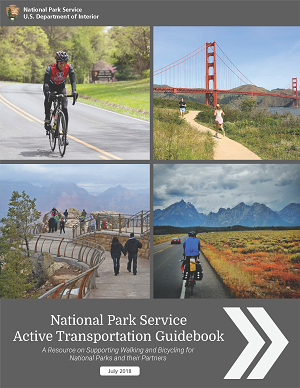New Guidebook Offers Strategies to Enhance Active Transportation at National Parks
Visitors to national parks are increasingly exploring natural and cultural resources in new ways, including through active transportation—by foot, bicycle, and other non-motorized modes.
A new guidebook from the National Park Service (NPS) is helping parks, their partners, and nearby communities to meet this demand, by pursuing projects and initiatives that enhance active transportation.
“With growing visitation numbers, parks and communities are tackling a variety of visitor and resource management issues—vehicle congestion, poor air quality, and wildlife-vehicle impacts, to name a few,” said Krista Sherwood, a project lead representing the NPS Conservation and Outdoor Recreation Programs. “Providing ways for visitors to arrive at and explore these important places, without needing a car, can help mitigate negative impacts and make parks more bicycle and pedestrian-friendly.”

The Guidebook covers a number of walking and bicycling topics to improve safety, mobility, and visitor experience through active transportation projects and programs. (NPS photo)
NPS developed the Guidebook with technical support from the U.S. DOT Volpe Center, working with bicycle and pedestrian professionals, transportation experts, NPS staff, and partners, including the Federal Highway Administration.
“This guidebook is a tremendous resource for parks, their partners, and communities to implement initiatives that improve bicycle and pedestrian safety, encourage healthy and sustainable programs, develop and fund infrastructure, and much more,” said Jessica Baas, a planner at the Volpe Center and principal technical lead for the development of the guidebook.
Active transportation improvements and related efforts can also promote economic growth in gateway communities by attracting visitors who support local businesses.
“These opportunities can add jobs and contribute to overall quality of life for communities, particularly in rural areas,” said David Daddio, a program manager at the Volpe Center.
How to Enhance Walking and Bicycling in Parks
The Guidebook provides guidance for parks—including policies, regulations, and examples—to improve safety, mobility, and visitor experience through active transportation projects and programs. It covers a number of walking and bicycling topics, and applies them within the unique context and needs of national parks. The Guidebook includes the following topics:
- Implementing active transportation infrastructure, such as pedestrian paths, multiuse trails, pavement marking, signage and wayfinding, and bicycle sharing systems and rental programs.
- Evaluating and improving safety for active transportation modes through infrastructure enhancements, education, and coordination with law enforcement.
- Incorporating innovation and emerging technologies, including existing and emerging count data sources, mobile applications, electric and fat-tire bicycles, and automated vehicles.
- Offering activities and programs that provide visitors interpretive opportunities and the chance to walk or bicycle while enjoying parks in new ways, such as open-street events.
“Parks often need champions to enhance active transportation,” Daddio said. “Staff capacity and funding can be challenges, so the guidebook offers parks practical steps and the tangible tools to work with partners, leverage limited resources, and achieve results.”

Active transportation improvements and related efforts can also promote economic growth in gateway communities by attracting visitors who support local businesses. (NPS photo)
Real Examples of Active Transportation in Action
NPS staff and others interested in pursuing active transportation can learn from these and other real-world examples at federal- and state-managed lands:
- The Rocky Mountain National Park Multiuse Trail Plan outlines infrastructure options for a trail system along developed road corridors within the park and connecting to Estes Park, CO. As the plan is implemented, the trail system will create context-sensitive, multimodal connections for the park’s over four million annual visitors. New trails will connect key visitor destinations, Estes Park, and a seasonal shuttle system.
- The Natchez Trace Parkway implemented a bicycle safety campaign in 2014, in response to several bicyclist fatalities and severe injuries. The Parkway, which runs from Nashville, TN to Natchez, MS, is a premier bicycle touring destination. Park staff partnered with local and national stakeholders to improve safety through education and outreach campaigns, targeted enforcement, and improved signage.
- NPS partnered with the District of Columbia to jointly construct, maintain, and operate the Anacostia Riverwalk Trail on NPS property. By sharing limited resources and leveraging technical expertise, the two agencies have now partially completed the 20-mile trail system, providing new transportation and recreation opportunities for this underserved area.
- The U.S. Fish and Wildlife Service (FWS) is piloting bicycle and pedestrian counters at 30 of its stations across the country. The new data will help FWS track how people access refuges and plan and prioritize active transportation projects. Because pedestrian counters are often designed for urban areas, the pilot will also demonstrate which devices are most appropriate for the unique conditions and natural environments found in public lands.
“The guidebook includes many case studies and best practice examples,” Baas said. “These success stories can help spur ideas and let park staff and partners learn from other real-world examples that are improving bicycle and pedestrian access for parks and communities.”
Read the National Park Service Active Transportation Guidebook to learn about the strategies that parks are using to enhance walking and bicycling, construct infrastructure, improve safety, and embrace innovation.

The National Park Service developed its Active Transportation Guidebook with technical support from the Volpe Center, working with bicycle and pedestrian professionals, transportation experts, NPS staff, and partners, including the Federal Highway Administration.
